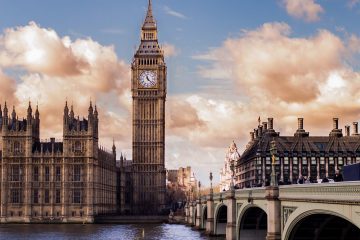London, a city steeped in history and buzzing with modernity, is a melting pot of cultures, ideas, and aspirations. As we turn our gaze to the year 2024, the dynamic landscape of London’s population comes into sharper focus. Join us on a journey through the bustling streets and quiet alleys as we unravel the tapestry of London’s population in the coming years. From trends and forecasts to the stories of the people who call this vibrant city home, this article will paint a vivid picture of London’s population in 2024. Let’s explore the diverse tapestry that makes up the very heart of this iconic city.
Table of Contents
- Exploring the Demographic Trends of London in 2024
- Challenges and Opportunities of London’s Growing Population
- Sustainable Solutions for Managing Urban Growth in London
- Creating Inclusive Policies to Support a Diverse Population
- Enhancing Infrastructure to Accommodate London’s Increasing Residents
- Q&A
- The Conclusion


Exploring the Demographic Trends of London in 2024
London in 2024 continues to showcase fascinating demographic trends that shape the city’s vibrant landscape. As we delve into the population dynamics of this bustling metropolis, it becomes evident that diversity is not just a word but a way of life in London. From the colorful streets of Camden to the historical alleys of Westminster, every corner of the city tells a unique story of multiculturalism and inclusivity.Key Demographic Trends:
- Ethnic Diversity: London’s population in 2024 represents a mosaic of ethnicities, with communities from all over the world calling it home.
- Age Distribution: The age spectrum in London remains diverse, with a blend of young professionals, families, and retirees contributing to the city’s dynamic social fabric.
Forecasted Growth:
| Year | Population Estimate |
|---|---|
| 2025 | 9.2 million |
| 2026 | 9.5 million |
| 2027 | 9.8 million |
As we gaze into the future, London’s population is projected to continue its upward trajectory, embracing change while cherishing its rich heritage.
Challenges and Opportunities of London’s Growing Population
London, as one of the most dynamic cities in the world, faces a multitude of challenges and opportunities stemming from its rapidly growing population. With this influx of residents, the city grapples with urban sprawl, housing shortages, and increased strain on transportation networks. However, within these challenges lie opportunities for innovation, cultural enrichment, and economic growth.
As the population of London continues to rise, the demand for sustainable infrastructure, affordable housing, and efficient public services escalates. Embracing technological advancements, promoting green initiatives, and fostering community engagement are pivotal in transforming these challenges into opportunities for a more resilient and inclusive city. By leveraging the diversity and creativity of its inhabitants, London can navigate through these complexities and emerge as a global leader in urban development.


Sustainable Solutions for Managing Urban Growth in London
As London’s population continues to grow, the need for sustainable solutions to manage urban expansion becomes increasingly imperative. Embracing eco-friendly practices and innovative approaches can help address the challenges of accommodating a rising number of residents while preserving the city’s unique character and heritage.
**Implementing green infrastructure** such as rooftop gardens, community parks, and urban farms can not only enhance the quality of life for Londoners but also contribute to mitigating the effects of urbanization on the environment. **Encouraging sustainable transportation** options like cycling lanes, pedestrian-friendly pathways, and efficient public transport systems can reduce congestion, air pollution, and carbon emissions, making the city more livable for all its inhabitants.


Creating Inclusive Policies to Support a Diverse Population
Creating inclusive policies is crucial to promoting a sense of belonging and support for all residents. By ensuring that policies are designed to accommodate the diverse needs of the population, London can foster a more inclusive and equitable society. **One way to achieve this is by implementing language access policies that provide translations and interpretation services for non-English speakers, making information more accessible to a wider audience.**Moreover, prioritizing affordable housing initiatives can help address the needs of marginalized communities and alleviate housing insecurities. By developing programs that cater to diverse incomes and backgrounds, London can create a more inclusive environment where everyone has access to safe and affordable housing options. This commitment to inclusivity not only strengthens the social fabric of the city but also promotes economic empowerment and social cohesion among its residents.
| Benefits of Inclusive Policies: | Impact on London’s Population: |
|---|---|
| Enhanced sense of belonging | Improved social cohesion |
| Increased accessibility to services | Promotion of diversity and inclusion |
| Addressing housing insecurities | Empowerment of marginalized communities |


Enhancing Infrastructure to Accommodate London’s Increasing Residents
To address the growing population in London, it’s crucial to focus on infrastructural improvements that can support the increasing number of residents. By investing in **modern transport systems**, such as expanding subway lines and implementing faster bus routes, we can ensure smoother commutes for all Londoners. Additionally, **upgrading public spaces** like parks and community centers can enhance the quality of life for residents and provide much-needed recreational areas in urban settings.Moreover, sustainable housing solutions are essential to accommodate the rising population while maintaining a balance with the environment. Building energy-efficient and affordable housing options can help combat the housing crisis in London and promote inclusivity within the community. By prioritizing these infrastructure enhancements, London can pave the way for a more livable and vibrant city for its residents in 2024 and beyond.
Q&A
Q: What is the projected population of London in 2024?A: The projected population of London in 2024 is estimated to reach over 9 million people, continuing the city’s trend of steady growth.
Q: What factors are contributing to the growth of London’s population?
A: Factors contributing to the growth of London’s population include immigration, natural population increase, and the city’s economic opportunities and cultural attractions.
Q: How might the increasing population impact the city’s infrastructure?
A: The increasing population in London may put pressure on the city’s infrastructure, leading to challenges in housing availability, transportation systems, and healthcare services.
Q: Are there any initiatives in place to address the population growth in London?
A: To address the population growth in London, city officials have been implementing urban planning strategies, affordable housing programs, and public transportation improvements to accommodate the expanding population.
Q: What does the future look like for London with a growing population?
A: With a growing population, London is poised to remain a vibrant and diverse metropolis, but city planners will need to navigate the challenges of sustainability, inclusivity, and quality of life to ensure a prosperous future for all residents.





0 Comments